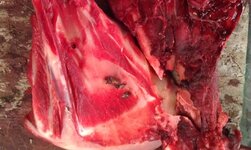If you want to anchor an elk, shot #1 goes double lungs.... shot #2 goes CNS. I've seen elk run off with a leg missing.
A mono works based on hydraulic reaction. Keep it smashing wet stuff before the tip plugs with bone.
The only thing ANY bullet does better than a partition is beat the drag.
It doesn't take big, fast or mono to bust shoulders. That's a 6.5/140 bullet at MUCH farther than you're talking about, impact velo around 1800iirc. The onside scapula is the pencil hole, the offside is busted up. This is a bull elk.
A mono works based on hydraulic reaction. Keep it smashing wet stuff before the tip plugs with bone.
The only thing ANY bullet does better than a partition is beat the drag.
It doesn't take big, fast or mono to bust shoulders. That's a 6.5/140 bullet at MUCH farther than you're talking about, impact velo around 1800iirc. The onside scapula is the pencil hole, the offside is busted up. This is a bull elk.

